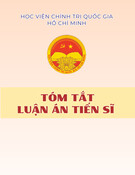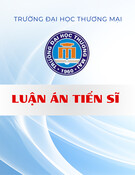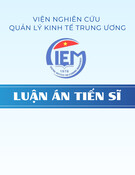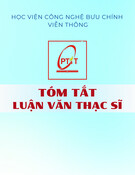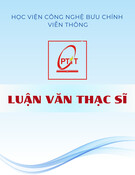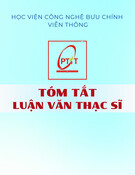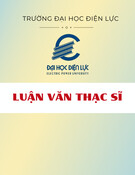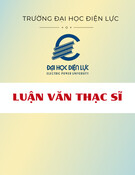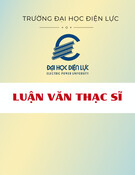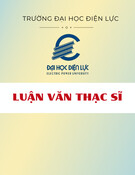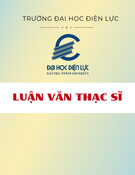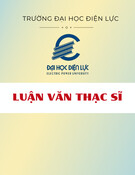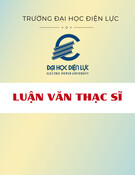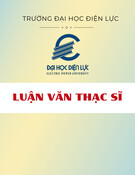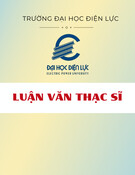
MINISTRY OF EDUCATION AND
TRAINING
MINISTRY OF AGRICULTURE
AND RURAL DEVELOPMENT
THUYLOI UNIVERSITY
NGUYEN THI MUI
STUDY ON WATER RESOURCES SECURITY FOR
SUSTAINABLE DEVELOPMENT OF MA RIVER BASIN
Major: Soil and Water Environment
Specialized Code: 9 44 03 03
SUMMARY OF TECHNICAL PHD THESIS
HANOI, 2018
1

The research is completed at Thuyloi university
Scientific instructor: Prof. Dr. Le Đinh Thanh
Name of Supervisor 1:
Name of Supervisor 2:
Name of Supervisor 3:
The dissertation shall be defensed at the Thesis Assessment Board
of the University at ...... on ...........
The dissertation may be found at the library:
- National Library
- Thuyloi university library
2

PREAMBLE
1. Rationales
At present, WRS (WRS) has become a major and urgent issue for many river
basins and regions in the world, especially for transnational river basins and
water-scarce territories.
The Ma river basin is considered to be a place where has limited potentiality of
water. However, there are still tensions in the exploitation and use of water
resources for the following reasons: (i) The unequal distribution of water
resources both in terms of space and time has caused floods and droughts,
affecting the exploitation and use of water among regions in the basin; (ii)
Disasters, floods and droughts on the Ma river system frequently occur; (iii)
The hydrological regime in the main stream and on the tributaries of the Ma
River basin has changed a lot due to the consequence of the construction and
exploitation by small and medium water-use works in the basin. In addition,
extremely unusual weather patterns and climate change are also major causes of
storms, floods and depletion of water resources in the basin; (iv) Water in the
basin has been seriously polluted, specially on the Lung, Lach Truong, Yen
rivers, and downstream of the Ma river. To contribute more scientific and
practical foundations for planning, exploitation and management of water
resources with an aim to promote more sustainable socio-economic
development and more effectively protect environment in the Ma river basin in
the curent conditions, it is necessary to develop "indicators for WRS " as a tool
for the sustainable development in the basin.
2. Research purposes
- To establish indicators of WRS for river basins in Viet Nam which are
appropriate to charateristics and water use of basins;
- To use the proposed indexs to assess WRS for typical regions in Ma river
basin; subsequently, proposing oriented solutions to make WRS feasible and
appropriate to real conditions.
3

3. Research subjects and scope
The research subjects are the elements of surface water resources and
environment in the Ma river basin in order to establish a "set of indicators" for
WRS and sustainable environmental protection.
The spatial scope: The Ma river basin in the territory of Vietnam (including
Dien Bien, Son La, Hoa Binh, Nghe An and Thanh Hoa provinces).
The temporal scope: to identify indicators for WRS in the Ma River basin in
2015 and in the future by 2030.
4. Research approaches and methods
The research approaches: from systematic, integrated management of water
resources and sustainable development standpoints
The research methods: the method of field survey; the method of inheritance
and expert analysis; the method of environmental hydrological modeling; the
methods of statistical analysis and synthesis; and the map method.
5. Scientific and practical significance
Scientific significance: contributing to raising awareness, updating knowledge
and methodology on WRS in Vietnam, especially direct researches on WRS in
the Ma river basin haven’t been conducted yet.
Practical significance: contributing to improving the efficiency of the
exploitation and use of water resources by indicators for WRS and proposing
some solutions to the sustainable environmental protection in the different
regions in the Ma river basin. From there, further researches on other basins
could be conducted.
6. New contributions
- The dissertation studies and formulates a set of indicators for WRS in
accordance with the conditions and characteristics of the exploitation and use of
water resources in the river basins in Vietnam to serve sustainable socio-
economic development in the basins
- Applying the proposed set of indicators for WRS to calculate indicators for
three typical regions with high levels of water and environmental pressures in
the Ma river basin. From that, some solutions to WRS are proposed to enhance
sustainable socio-economic development and environmental protection in the
basin.
4

CHARTER 1: AN OVERVIEW OF WATER RESOURCES SECURITY
AND INTRODUCTION TO MA RIVER BASIN 1.1. Definitions of
water resources security
At present, there are various definitions of WRS such as:
In 2000, the Global Water Partnership introduced the concept of WRS, which is
that "WRS is the guarantee of water safety at all levels from home to global. It
means that everyone is provided with sufficient clean water with affordable
costs in order to meet their essential needs in lives and at the same time,
ensuring that the natural environment is preserved and promoted"
In 2007, D.Grey and C.W.Sadoff defined the "WRS" as the availability of water
in terms of its reserves and quality for health, lives, ecosystems, and production
taking the risk to people, environment and economy into account". To put it
simply, WRS involves the exploitation and use of water resources while
limiting negative impacts on them.
1.2 An overview of water resources security
In the world, WRS has been studied in terms of both methodology and a set of
indicators applied to different regions. Each research has its own approaches
and each researched region has its different characteristics so that indicators for
WRS and calculation methods applied are also different.
In Vietnam, WRS is a new issue so that there are very few studies on it. This
issue is still open, not yet studied in the Ma river basin,
Figure 1.1 The map of the Ma
river basin and its vicinity
5
1.3. Introduction to the Ma river
basin
1.3.1. The Ma river basin and its
major tributaries
The Ma river basin covers Dien
Bien, Son La, Hoa Binh, Nghe An,
Thanh Hoa provinces and a part of
Lao PDR. The total area of the basin
is 28,400 km2, in which the Vietnam
area is 17,600 km2, accounting for

